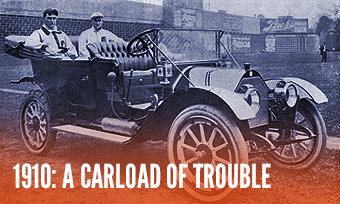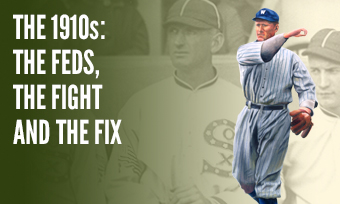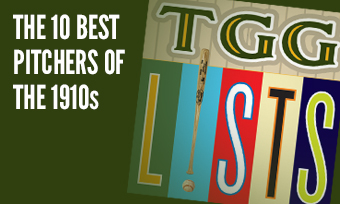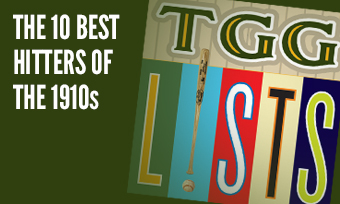The Yearly Reader
Leaders and Honors, 1910
Our list of baseball’s top 10 hitters and pitchers in both the American League and National League for the 1910 baseball season, as well as the awards and honors given to the game’s top achievers of the year.
The National League’s Top 10 Hitters, 1910
Bold type in brick red indicates league leader.
1. Sherry Magee, Philadelphia
Key Numbers: .331 average, 110 runs, 172 hits, 39 doubles, 17 triples, 6 home runs, 123 RBIs, 94 walks, 49 stolen bases, .445 on-base percentage, .507 slugging percentage.
Wait, what—somebody besides Honus Wagner occupies this spot? Yes, Magee is the first other player since the turn of the century to legitimately claim that he’s the best NL hitter.
2. Solly Hofman, Chicago
Key Numbers: .325 average, 83 runs, 16 triples, 86 RBIs, 65 walks.
Frustrated for years at Chicago because he never got a core position he could call his own, Hofman put together the kind of numbers that forced the Cubs to play him every day, somewhere. (In 1910, that was usually center field.)
3. Honus Wagner, Pittsburgh
Key Numbers: .320 average, 90 runs, 178 hits, 34 doubles, 81 RBIs.
Never mind losing the top spot on this list—Wagner was just happy to be alive after escaping serious injury from a car crash in May.
4. Ed Konetchy, St. Louis
Key Numbers: .302 average, 87 runs, 16 triples, 78 RBIs, 78 walks.
Konetchy began a decade in which he would dominate defensively at first base—and his hitting wasn’t all that bad, either.
5. Johnny Bates, Philadelphia
Key Numbers: .305 average, 91 runs, 26 doubles, 11 triples, 61 walks, 31 stolen bases.
That Bates hit the .300 mark for the first and only time of his career wasn’t enough for crusty teammate Sherry Magee, who continued to criticize him to the point that Bates asked for a trade. He’d get one, a year later, to Cincinnati.
6. Fred Snodgrass, New York
Key Numbers: 396 at-bats, .321 average, 8 triples, 71 walks, 33 stolen bases, .440 on-base percentage.
In his first full season, Snodgrass had a shot at the NL batting title but slipped over the last month; he finished a close second to Magee in on-base percentage.
7. Larry Doyle, New York
Key Numbers: .285 average, 97 runs, 14 triples, 8 home runs, 71 walks, 39 stolen bases.
Despite a mild drop-off in his batting average, Doyle was still easily considered the heart and soul of the Giants’ lineup.
8. Bobby Byrne, Pittsburgh
Key Numbers: .296 average, 101 runs, 178 hits, 43 doubles, 12 triples, 66 walks, 36 stolen bases.
The lightweight Byrne reminded Pirates fans of Ginger Beaumont as a top-of-the-lineup spark, minus the red hair.
9. Wildfire Schulte, Chicago
Key Numbers: .301 average, 93 runs, 29 doubles, 15 triples, 10 home runs, 68 RBIs.
Beginning a decade in which he’d be noted as one of the majors’ premier ‘sluggers,’ Schulte scored his first of two straight top placements on the home run list—with four of his 10 round-trippers swatted in two multi-homer games just three days apart in August.
10. Red Murray, New York
Key Numbers: .277 average, 78 runs, 87 RBIs, 57 stolen bases.
Solid but not sensational, as always, Murray continued to give strong contributions to the Giants’ offense and led the team in stolen bases.
The American League’s Top 10 Hitters, 1910
1. Ty Cobb, Detroit
Key Numbers: .382 average, 106 runs, 194 hits, 35 doubles, 13 triples, 8 home runs, 91 RBIs, 65 stolen bases, .455 on-base percentage, .549 slugging percentage.
Cobb began a remarkable four-year stretch in which he would bat .402—while the rest of the AL dragged along at .257.
2. Nap Lajoie, Cleveland
Key Numbers: 159 games, .383 average, 592 at-bats, 94 runs, 227 hits, 51 doubles, 76 RBIs.
Lajoie was allowed to concentrate full-time on playing after stepping down as the Naps’ manager. Result: A 60-point upswing in his average, and his first batting title in six years—with a little help from the St. Louis Browns.
3. Eddie Collins, Philadelphia
Key Numbers: .324 average, 188 hits, 15 triples, 81 RBIs, 81 stolen bases.
The fleet-of-foot Collins, at age 23, set a franchise mark for steals that would hold until Rickey Henderson starting going triple-digits in the 1980s.
4. Tris Speaker, Boston
Key Numbers: .340 average, 92 runs, 183 hits, 14 triples, 7 home runs, 35 stolen bases.
In his second full season, “Spoke” established himself as a major star in Boston, finishing third in the AL batting race.
5. Sam Crawford, Detroit
Key Numbers: .289 average, 26 doubles, 19 triples, 5 home runs, 120 RBIs.
Although his batting average was the second lowest of his big-league career over a full season, Crawford set a personal best in RBIs; having Ty Cobb bat in front of you will do that.
6. Jake Stahl, Boston
Key Numbers: .271 average, 16 triples, 10 home runs, 77 RBIs, 128 strikeouts.
Stahl reached a career peak with his power numbers, while striking out 128 times—the most by an AL player until Jim Lemon in 1956.
7. Birdie Cree, New York
Key Numbers: .285 average, 13 triples, 36 stolen bases.
The rising star received the ultimate baseball baptism of the time: Getting hit in the head by a Walter Johnson fastball and living to tell about it.
8. Frank Baker, Philadelphia
Key Numbers: .283 average, 83 runs, 25 doubles, 15 triples, 74 RBIs.
Baker showed little signs of what would earn him the nickname “Home Run” a year later; he only hit two in 1910, the fewest he’d ever collect in a full season.
9. Danny Murphy, Philadelphia
Key Numbers: .300 average, 28 doubles, 18 triples.
Baseball middle age (read: mid-30s) wasn’t slowing the long-time Athletic, as he hit .300 or better for the first of five straight years.
10. Rube Oldring, Philadelphia
Key Numbers: .308 average, 79 runs, 168 hits, 27 doubles, 14 triples.
It’s safe to say that Oldring was a more relaxing clubhouse element than an earlier Rube (Waddell) who occupied a spot on the A’s roster.
The National League’s Top 10 Pitchers, 1910
1. Christy Mathewson, New York
Key Numbers: 1.89 ERA, 27 wins, 9 losses, 27 complete games, 318.1 innings, 184 strikeouts.
Mathewson led the NL in wins for the fourth and last time in his career.
2. Three Finger Brown, Chicago
Key Numbers: 1.86 ERA, 25 wins, 14 losses, 7 saves, 27 complete games, 6 shutouts, 46 appearances, 295.1 innings.
Brown remained the center of the Cubs’ pitching universe, winning at least 25 games for the third year in a row.
3. Babe Adams, Pittsburgh
Key Numbers: 2.24 ERA, 18 wins, 9 losses.
Solid follow-up for the Pirates’ 1909 rookie wonder, including a terrific stretch run in which he went 7-0 in September.
4. George Suggs, Cincinnati
Key Numbers: 2.40 ERA, 20 wins, 12 losses, 266 innings.
After failing to crack an experienced Detroit rotation, Suggs earned a starting spot in Cincinnati and proved his worth.
5. King Cole, Chicago
Key Numbers: 1.80 ERA, 20 wins, 4 losses, .833 win percentage.
King Cole was a merry ol’ soul in his inaugural year, setting personal bests in a career that would promptly go downhill.
6. George McQuillan, Philadelphia
Key Numbers: 1.60 ERA, 9 wins, 6 losses.
Using modern rules, McQuillan’s superb ERA fell just two-thirds of an inning shy of being eligible for the ERA title. Maybe he would have made that up had he not started drinking—something that would lead the Phillies to trade him after the season.
7. Earl Moore, Philadelphia
Key Numbers: 2.58 ERA, 22 wins, 15 losses, 6 shutouts, 283 innings, 185 strikeouts.
At age 33, Moore completed a comeback from a late 1900s downturn largely of his own making (i.e., holdouts).
8. Nap Rucker, Brooklyn
Key Numbers: 2.58 ERA, 17 wins, 18 losses, 39 starts, 27 complete games, 6 shutouts, 320.1 innings.
The Georgia-born southpaw continued to endure frustration by pitching well for a lousy team that kept him from even reaching .500.
9. George Bell, Brooklyn
Key Numbers: 2.64 ERA, 10 wins, 27 losses, 310 innings.
Not to be confused with the future Toronto Blue Jays slugger—but you probably knew that already—Bell had it far worse than Rucker, setting a franchise record for losses despite an ERA that was better than the league average.
10. Red Ames, New York
Key Numbers: 2.22 ERA, 12 wins, 11 losses.
The curveball specialist may have pitched so well that his ball kept curving about even after they were put in play; 40% of the runs he allowed were unearned.
The American League’s Top 10 Pitchers, 1910
1. Ed Walsh, Chicago
Key Numbers: 1.27 ERA, 18 wins, 20 losses, 5 saves, 45 appearances, 369.2 innings.
To the ace, the spoils of designing your team’s ballpark; Walsh suggested the pitcher-friendly dimensions at newly-opened Comiskey Park, but ended up becoming the first (and still only) 20-game loser to win an ERA title.
2. Walter Johnson, Washington
Key Numbers: 1.36 ERA, 25 wins, 17 losses, 45 appearances, 42 starts, 38 complete games, 370 innings, 313 strikeouts, 21 wild pitches.
And to think; people in and around D.C. were clamoring for the Senators to trade the Big Train after a wobbly start.
3. Jack Coombs, Philadelphia
Key Numbers: 1.31 ERA, 31 wins, 9 losses, 45 appearances, 38 starts, 13 shutouts, 353 innings.
Coombs exploded on the pitching mound after four years of yielding average rate of returns for the A’s. He would be on of two 30-game winners in franchise history; the other was Lefty Grove, who match his 31 wins in 1931.
4. Russ Ford, New York
Key Numbers: 1.65 ERA, 26 wins, 6 losses, .813 win percentage, 299.2 innings.
The man who discovered the soon-to-be-allowed scuffball by accident set a rookie mark for wins that would last barely a year (Pete Alexander, 1911).
5. Chief Bender, Philadelphia
Key Numbers: 1.58 ERA, 23 wins, 5 losses, .821 win percentage, 250 innings.
The long-time Athletic had his best year, setting personal marks in wins and ERA.
6. Cy Morgan, Philadelphia
Key Numbers: 1.55 ERA, 18 wins, 12 losses, 290.2 innings, 117 walks.
Playing his first full season for the A’s after a midseason trade from Boston the year before, Morgan made up for lost time after reporting for camp out of shape.
7. Ray Collins, Boston
Key Numbers: 1.62 ERA, 13 wins, 11 losses.
The young lefty was never more efficient than in 1910, his first full season with the Red Sox.
8. Smoky Joe Wood, Boston
Key Numbers: 1.69 ERA, 12 wins, 13 losses.
The won-loss record might come off as a modest warm-up for the 20-year old whose most spectacular numbers were just around the corner—but his ERA would be the lowest of his life.
9. Eddie Plank, Philadelphia
Key Numbers: 2.01 ERA, 16 wins, 10 losses, 250.1 innings.
Per the usual, the veteran A’s ace quietly went about his business of excellence while others (Jack Coombs, Chief Bender and Cy Morgan, above) got more of the attention.
10. George Mullin, Detroit
Key Numbers: 2.87 ERA, 21 wins, 12 losses, 289 innings.
Though he walked more batters (102) than he struck out (98), Mullin managed to pull in his fifth and final 20-win performance.









